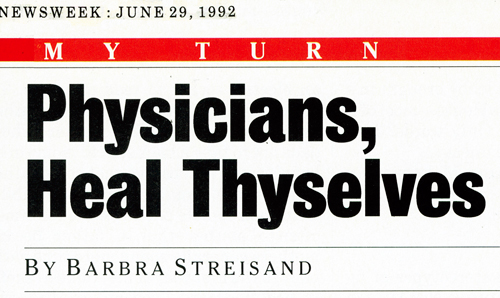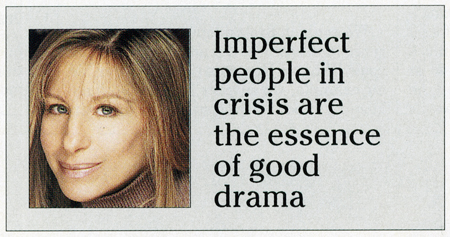Physicians, Heal Thyselves
Newsweek
June 29, 1992
By Barbra Streisand

Some months have passed since the film “The Prince of Tides” was released. And though I have generally been pleased with the way critics and especially the public received the movie, one aspect still rankles: criticism— mostly from psychiatrists—of the doctor-patient relationship in the story. I feel compelled, therefore, to answer those who have attacked the character of the character Dr. Susan Lowenstein, who has been knocked for everything from the length of her fingernails to the way she crossed her legs (as if women can’t get medical degrees and manicures, be professional and glamorous). I suppose these quibbles are fair comment and harmless enough. But it’s something else again when doctors are quoted in articles in major newspapers and magazines or appear on TV accusing me of such things as glorifying a psychiatrist who “victimizes her patients,” and setting back the entire therapeutic process.
First of all, those psychiatrists who self-righteously proclaim to be shocked by the portrayal of a romantic relationship between a therapist and a patient either don’t read the newspapers or are living in their own bubble of denial. They also didn’t pay much attention to the movie, since Nick Nolte’s character, Tom Wingo, was not Lowenstein’s patient. His sister was her patient. He did not solicit her help; she sought his—so she did not violate his trust. Some would say that a therapist’s having a relationship with the brother of a patient, even after the consultation process is over, is equally unethical. Maybe it is. But that is the story.
“The Prince of Tides” is not a documentary. It is a movie based on the best-selling novel by Pat Conroy, a work of fiction not about the behavior of psychiatrists but about family dysfunction and love and healing. It is a story of family secrets, of rooms too long locked and in need of airing out. It is a story about turning on a light at night to discover that the ominous black shape in the corner is only a chair after all. It is also about synchronicity, about people who meet each other at particular moments in their lives, at crossroads where—unknown to them—life-changing decisions are about to be made. They sometimes decide after standing at the crossroads for a while to take the same path. Sometimes they choose to go separate ways. It is the moment together at the crossroads that matters.
Tom Wingo and Susan Lowenstein came together at such a crossroads. Lowenstein is not a classical Freudian analyst who would never meet with her patient’s brother in the first place. She is a therapist who transacts, interacts, reacts. All in the attempt to heal and to help bring change in others.
She is also a woman with her own problems. I chose to play the character of Lowenstein because she is a wounded healer. I know she exists, this woman capable of healing others yet needing help herself. Imperfect, human, like the rest of us. Where is it written that doctors have to be perfect, have to be gods? Even Freud had agoraphobia (an irrational fear of open spaces) and at the age of 70 still found it difficult to cross a street without holding on to someone’s arm.

Human growth: It is not my job to judge the ethics of the therapeutic community. From that first famous psychoanalytic case, where Dr. Joseph Breuer treated Anna O. in 1880, sexuality between patient and therapist has been a heart-wrenching presence. Recent studies show it’s still a troubling issue—but that’s a problem for doctors to address. My job, as I see it as a responsible filmmaker, is to examine issues that I feel passionate about—to tell stories about positive transformations and the potential for human growth. To reflect life, and truth, as I’ve come to understand it. There is a danger in taking art too far down the road of political correctness. Life and truth, after all, are always seen through many lenses. Movies are no different. Lowenstein is no different.
Realism and accuracy are important if one wants to tell a story that rings true. And just as I worked hard to make sure the shrimping scenes in the movie were authentic, I did a great deal of research about therapy and therapists. I consulted psychiatrists, traditional Freudian analysts, clinical psychologists, therapists of many schools. Not one of them questioned the plausibility of the plot of “The Prince of Tides” or the characters. I read extensively. I attended seminars about the healing process alongside therapists and therapists in training. I was fascinated to learn that so many of them were in pain themselves. Perhaps many therapists are drawn to the mysteries of the human psyche precisely because they are capable of understanding and empathizing on a deep level with those who seek their help.
The criticism in the media would sting more if not for all the letters of support I have received. Many therapists have told me they recommend that their patients see the movie. I have also heard from many people, including patients, who told me how the film affected their lives in a positive way, or gave them insight into the therapeutic process they had never had before.
Nobody writes stories about perfect people; indeed, imperfect people in crisis are the essence of good drama. From the great success of the novel and now the film, it’s clear many identify with this compelling story about parents and children, men and women; about love and how it can destroy as well as heal; about guilt, about blame, about forgiveness, about how facing one’s past can lead to acceptance and renewal — about life. It was this I was drawn to. I wanted to film this book because of my belief that troubled people can be helped by gifted and compassionate professionals. That they can emerge from the process healthier and stronger, that all wounds can heal and that broken families can mend and come together again. I think these are the messages of “The Prince of Tides,” and I am proud to have delivered them.
___________
Streisand produced, directed and starred in the film.
END.
